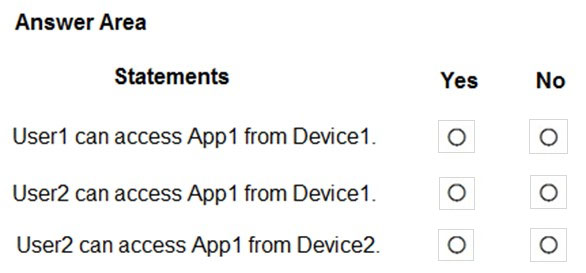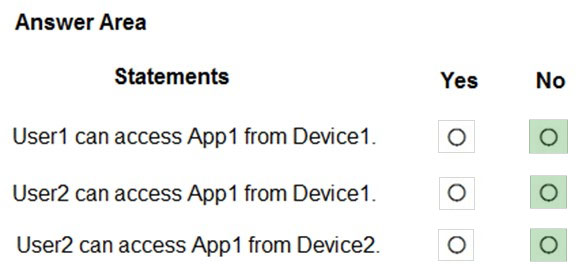

HOTSPOT -
You have a Microsoft 365 subscription that uses a default domain named contoso.com. The domain contains the users shown in the following table.
The domain contains the devices shown in the following table.
The domain contains conditional access policies that control access to a cloud app named App1. The policies are configured as shown in the following table.
For each of the following statements, select Yes if the statement is true. Otherwise, select No.
NOTE: Each correct selection is worth one point.
Hot Area:

PersonT
Highly Voted 4 years, 3 months agoALPHA_DELTA
4 years, 3 months agoIgorMatic
4 years, 3 months ago365admin
4 years, 2 months agoDomza
3 years, 10 months agoKing2
Highly Voted 4 years, 1 month agoBouncy
3 years, 1 month agolucidgreen
3 years, 11 months agoFeyenoord
Most Recent 2 years, 2 months agoFala_Fel
2 years, 6 months agoEsamiTopici
2 years, 5 months agornd3131
2 years, 10 months agoSaeedFarvardin
2 years, 10 months agoSaeedFarvardin
2 years, 10 months agoTimNov
3 years agoVirtualJP
3 years, 6 months agoVirtualJP
3 years, 6 months agous3r
3 years, 6 months agoedzio
3 years, 2 months agoallesglar
3 years, 7 months agoallesglar
3 years, 7 months agoSuperciuk
3 years, 7 months agoZuluHulu
3 years, 8 months agoVelda
3 years, 8 months agoChris_Rock
3 years, 10 months agolarnyx
3 years, 10 months agoNikPat3125
4 years agolucidgreen
3 years, 11 months agoklosinskil
3 years, 10 months agodonathon
4 years, 1 month ago